Riding a motorcycle is thrilling -the wind on your face and the freedom of the open road. But hold on, it is not all sunshine and smooth rides.
Safety is a big deal when you are out there riding your bike. To stay safe, follow these helpful tips to buy a helmet for bike to enjoy a safe ride. A staggering 14% of traffic deaths in America involve motorcycles. Yet wearing a helmet slashes the risk of dying by over a third. Impressive, right?
But here’s the kicker! Just wearing a helmet is not enough. A poorly chosen helmet can still leave you vulnerable. That’s why finding the right helmet is as important as wearing one. Because it is not just about looking cool, but also about staying safe and comfortable while riding.
This article is a lifesaver and helpful in choosing the right helmet.
What Are Helmets Made of?
Helmets are lifesaving shields made from a mix of high-tech materials. These materials are described below:
Polycarbonate/Plastic
- Advantage: Helmets made of polycarbonate/plastic are lightweight, affordable, and highly durable. They are great at absorbing impacts.
- Disadvantage: Scratches easily and might not last as long as some expensive materials
Fiberglass Composite
- Advantage: Flexible yet tough. It distributes impact force effectively and is relatively lightweight.
- Disadvantage: More expensive and can crack under extreme pressure instead of absorbing it.
Carbon Fiber
- Advantage: Ultra-light and incredibly strong. It is a premium material for riders looking for top-notch protection and style.
- Disadvantage: Costly and may not be the most scratch-resistant option.
You will find expanded polystyrene (EPS) foam inside nearly all helmets. This EPS foam absorbs impact energy at the time of a crash.
Why Are Helmets Necessary?
Helmets are a gear that protects you from injury. On top of that, it is part of the safety law for riding motorbikes almost everywhere in the world. Here is more on why you need a helmet.
Head Protection and Injury Prevention
Helmets are your first thing to defend your safety in an accident. They absorb the impact and reduce the risk of traumatic brain injuries, potentially saving your life.
Protection Against Harsh Weather Conditions
Helmets shield you from nature’s unpredictable moods, such as rain and scorching heat. They also keep you comfortable and focused.
Noise Reduction
Wind noise can be deafening at high speeds. This can easily distract you and divert your attention from the road. But a good helmet reduces the noise, allowing you to concentrate on riding.
Visibility Enhancement
Helmets with visors protect your eyes from specks of dirt, bugs, and other things. Some even come with anti-fog coatings. It enhances a clear vision in all conditions.
Psychological Confidence for Riders
Wearing a helmet is not always about physical protection, it’s about the confidence to enjoy the ride.
Legal Requirements
Wearing safety helmets is often the law. Many countries and states mandate helmet use for motorcyclists. For example, the law for wearing helmets in the U.S. varies by state. Some states have universal helmet laws; others only require helmets for younger riders. Then again, there is no helmet law in states like New Hampshire, Iowa, and Illinois.
Anatomy of a Helmet
A helmet is like a small engineering marvel, packed with parts that work together to keep you safe and comfortable. Now, let’s explore its key components and their roles.
1. Outer Shell
The helmet’s tough outer shell is built with polycarbonate, fiberglass, or carbon fiber. It shields against sharp objects and spreads the force across its surface. It also prevents concentrated blows that could cause devastating injuries.
2. Impact-Absorbing Liner
You will find the liner for absorbing impacts, below the outer shell. This liner is made of expanded polystyrene (EPS) foam. This layer is vital as it compresses upon impact to absorb and disperse energy. Thus, the liner helps reduce the shock that reaches your head.
3. Padded Comfort Layer
This layer is snuggled inside the helmet. It ensures a snug fit and prevents the helmet from feeling like a rock on your head. Made of soft, breathable material, it molds to your head shape over time for added comfort during long rides.
4. Chin Straps
Chin straps underneath the helmet are essential for keeping it securely in place. A helmet without a strap is useless, as it could fly off during an accident. These adjustable and padded straps ensure bikers’ comfort and safety.
5. Face Shield/Visor
The face shield or visor is located at the front of the helmet. It protects your eyes and faces from wind, grit, and junk. Many visors come with anti-fog or UV protection for enhanced visibility. It is a lifesaver when speeding down the highway or riding in bad weather.
6. Cheek Pads
Usually, full-face and ¾ helmets have cheek pads. These pads sit along the lower sides of the helmet, keeping it stable and secure. Much like padded comfort liners, they also add a layer of cushioning. As a result, the pads make the helmet feel more comfortable while reducing its movement during rides.
7. Vents
Vents are placed at the top, front, and rear to improve airflow inside the helmet. They prevent overheating and keep you cool, especially on long, sunny rides. Some helmets offer vents that you can open and close based on your comfort.
7 Common Types of Safety Helmets
We can see different types of helmets. Riders buy helmets depending on their needs, riding styles, and preferences. Let’s see their features, pros, and cons so that you can make an informed choice.
1. Full-Face Helmet
Full-face helmets are the most popular helmets. These helmets provide protection and shield your head, jaw, and face from impacts, debris, and harsh weather.
These helmets feature vents for airflow and visors for UV and anti-fog protection.
Pros:
- Maximum protection for head, chin, and face.
- Great for reducing wind noise.
- Shields against flying debris.
- Suitable for various weather conditions.
- Affordable choice.
Cons:
- Can feel heavy and bulky, especially during long rides.
- Limited ventilation in warmer climates.
- You need to remove it to eat or talk.
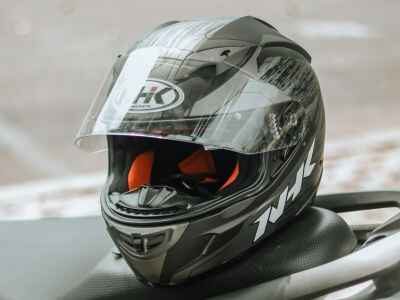

2. Flip-Up/Modular Helmet
Modular helmets have the safety of full-face helmets. They also have the flexibility of open-face helmets. The chin bar and visor can be flipped up, which allows riders to enjoy fresh air or have conversations without removing the helmet.
These helmets typically include advanced ventilation systems. These are constructed with durable materials similar to full-face helmets.
Pros:
- Versatile design.
- Convenient for quick stops, fueling, or brief conversations.
- Offers adequate protection.
Cons:
- These are heavier than full-face helmets because of the hinge system.
- Often more expensive than standard helmets.
- Less quiet than full-face helmets.
- Not exactly the safest choice.
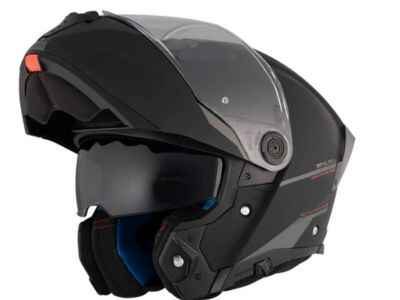

3. Half-Face Helmet
Half-face helmets protect just the crown of your head and sometimes extend to cover your ears. These helmets are minimalist in design, offering a lightweight and open feel.
Such helmets are popular among riders who prefer the wind in their face, such as cruisers or low-speed riders. Despite their limited coverage, half helmets have straps and padding for a secure fit.
Pros:
- Extremely lightweight.
- Comfortable to wear during long rides.
- Offers excellent ventilation.
- Easy to store and carry.
Cons:
- Doesn’t offer enough face protection.
- Keeps you exposed to harsh weather conditions.
- Not suitable for speeding.
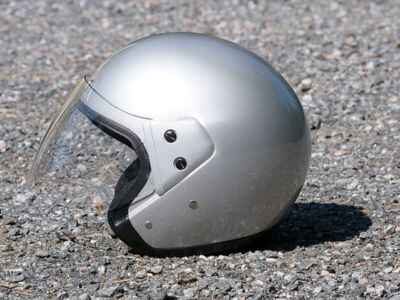

4. Open-Face or 3/4 Helmet
Open-face helmets are often known as 3/4 because they offer more coverage than half helmets. But it leaves your face exposed.
These helmets cover your head, the sides, and the back. They have a built-in visor for eye protection. However, they provide a good balance of coverage and an open-air experience.
Pros:
- Lightweight and comfortable.
- Convenient to use.
- Better ventilation and visibility.
Cons:
- Leaves the face and chin vulnerable in crashes.
- Doesn’t offer reduced noise.
- Can feel a bit unstable at times.
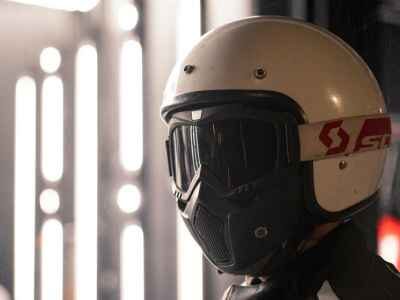

5. Off-Road Helmet
Off-road helmets are lightweight. They have maximum ventilation. They are designed for dirt biking, trail riding, and motocross.
A prominent peak visor and extended chin bar are signature features of these helmets. They protect the rider from mud, debris, and impacts. You should also know that these helmets usually require goggles for eye protection.
Pros:
- Lightweight design and comfortable.
- Allows you to wear glasses.
- Offers excellent ventilation.
- Extended chin bars improve breathing.
- Offers extra protection for the chin and neck.
Cons:
- Not ideal for riding on the streets.
- Often, they don’t come with visors.


6. Dual-Sport Helmet
Dual-sport helmets are a mix of full-face and off-road helmets. They are perfect for riders who switch between on-road and off-road.
This type of helmet has a sleek, aerodynamic design with a large visor and improved ventilation. You can use them with or without goggles.
Pros:
- Allows you to wear glasses or goggles.
- Offers great flexibility.
- Wide visor provides excellent visibility.
- Offers better ventilation than most helmets.
Cons:
- Can be quite heavy.
- Can feel bulky during long rides.
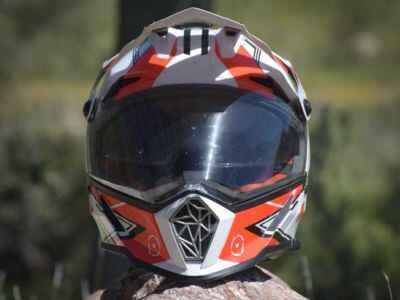

7. Smart Helmet
Just as the name suggests, smart helmets take safety to a new level. They have advanced technological features like Bluetooth connectivity, built-in speakers, cameras, and crash detection systems. Some models of smart helmets include heads-up displays for navigation and real-time road data.
Pros:
- Better quality and upgraded padding.
- Technologically advanced features.
- Crash detection and emergency alerts enhance riding safety.
- GPS navigation.
- Convenient hands-free communication.
Cons:
- The smart features can be distracting.
- Requires more frequent maintenance.
- Very expensive.
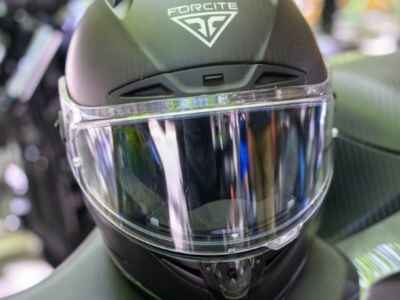

Tips to Buy a Helmet for Bike
Remember that when you want to buy a helmet for motorcycle, you are not just picking an accessory or fashion wear. You are selecting a life-saving device. So, to make the right decision, you need to consider various factors that balance safety, comfort, and practicality.
Now, let’s break down the key points to help you choose wisely.
Material
As I have discussed earlier in the article, the material of a helmet plays a very important role.
These materials are designed not only to absorb but also to distribute the force of an impact. That’s how the helmet protects your head during a crash. Since a high-quality material resists wear and tear, it eventually plays a vital role in the helmet’s durability.
Shape
There are three shapes of helmets. They are round oval, intermediate oval, and long oval. Each shape is designed to accommodate different head structures. A properly fitting helmet should sit evenly around your head, with no specific areas feeling too tight or loose.
Size
Size matters more than you might think when it comes to helmets. A helmet that is too big won’t stay securely in place. On the other hand, the one that is too small can cause significant discomfort.
To find the right size, start by measuring your head circumference and follow the following rules:
- Take a flexible tape, wrap it just above your eyebrows and ears to measure.
- Differentiate this with the size chart given by the manufacturer.
- After finding the size, try the helmet on. It should feel good and not painful.
- Shake your head gently to ensure it doesn’t wobble or move around.
Style and Features
Helmets come in a variety of colors, patterns, and finishes, which allow you to express your personality or match your bike’s aesthetics. Beyond looks, practical features like integrated sun visors, Bluetooth compatibility, or built-in cameras can enhance your riding experience.
Inner Liner and Cushioning
The inner liner and cushioning are essential components of a helmet, they contribute to both safety and comfort. The liner is designed to absorb the energy of an impact, reducing the force that reaches your head.
Meanwhile, the cushioning ensures a snug, comfortable fit by conforming to the shape of your head. High-quality cushioning is also breathable, wicks away moisture, and resists odors.
Comfort
Along with all the important things, you would want the helmet to be comfortable during all types of rides. That’s why you need to consider features like good ventilation, soft padding, and a lightweight design. Adjustable straps and a secure chin buckle add to the comfort by ensuring a proper fit.
Visibility
A good helmet should provide a clear and unobstructed field of vision. The visor should be durable, and scratch-resistant. Moreover, anti-fog coatings or pin-lock systems can prevent the visor from fogging up in cold or humid conditions.
In sunny days, tinted visors are very useful to ride. Just as clear ones are better for nighttime riding. So, buy a helmet that enhances visibility which will improve both safety and confidence on the road.
Safety Standards
No helmet is complete without meeting established safety standards. You should look for certifications like DOT (Department of Transportation), ECE (Economic Commission for Europe), or Snell when you buy a helmet.
These certifications indicate that the helmet has passed the testing for impact absorption, penetration resistance, and strap strength. That is why it is necessary to verify the certification before purchasing a helmet to ensure it meets the required safety criteria.
Cost
While it can be tempting to go for the cheapest option, you should never compromise with the quality. A higher price often reflects better materials, superior construction, and additional features like Bluetooth or anti-fog visors. Many mid-range helmets offer excellent protection and features.
The key is to balance affordability with quality. That way you can ensure the helmet provides the protection you need without overspending.
Can a Helmet Expire?
Yes, helmets can expire, and their lifespan depends on usage, materials, and care. Most manufacturers recommend replacing a helmet every 3 to 5 years, even if it hasn’t been involved in a crash.
Because, over time, the materials degrade. And that reduces the helmet’s ability to protect you during an impact. While proper care, cleaning, and storage can help extend its life, helmets are not meant to last forever. On top of that, regular use, exposure to sunlight, and harsh weather can accelerate this process.
Signs a Helmet Should be Replaced
Replace your helmet when you notice or experience the following:
- Cracks, dents, or visible damage on the outer shell.
- Loose, worn-out, or compressed padding.
- Frayed or damaged chin straps.
- Fading or peeling certifications or labels.
- The helmet doesn’t fit snugly anymore.
The Cost of Choosing the Wrong Helmet
A poorly chosen helmet might look fine. However, it cannot provide adequate head protection. On top of that, it is essentially useless during an accident. Since helmets are designed to absorb impact and reduce head injuries, an ill-fitting, low-quality, or uncertified helmet might fail when you need it most.
Physical and Emotional Damages
The physical consequences can be devastating. Even a minor crash could lead to serious injuries like concussions, skull fractures, or worse. Recovery from such injuries often involves expensive medical bills, time off work, and long-term health complications.
Saving a few bucks on a low-quality helmet could end up costing you thousands in hospital fees. And let’s not forget the emotional toll it takes knowing that a better helmet could’ve saved you from injury is a burden no one wants to bear.
Financial Damages
If you choose the wrong helmet, it means you will have to replace it sooner. Cheap materials degrade quickly, forcing you to buy a new one more often. It ultimately makes you waste money.
Avoid The Following Things When You Buy a Helmet
When shopping for a safety helmet, many users avoid some of the most critical aspects. So, make sure to avoid doing these for your own sake:
Choosing Style Over Safety:
Don’t pick a helmet just because it looks cool. When buying a helmet always look for certified ones that meet safety standards like DOT, ECE, or Snell.
Ignoring The Fit:
Never buy a helmet without trying it on. An improperly fitting helmet won’t protect you effectively, no matter how durable it is.
Skipping Size Measurements:
Avoid guessing your helmet size. Always measure your head circumference to find the right fit.
Opting For The Cheapest Option:
Low-cost helmets often compromise on quality, durability, and features. So, it is best not to jump on them just because there is a low-price tag.
Overlooking Comfort:
Don’t ignore comfort features like ventilation, cushioning, and weight. If you are a long-ride person, you need to prioritize them most.
Final Wisdom for a Safe Ride
A well-chosen helmet is the difference between fun, safe rides, and potential disasters. So, prioritizing safety and quality is a no-brainer.
A safe helmet should protect your head, fit comfortably, and meet necessary safety standards. And skipping these essentials or compromising for style or cost isn’t worth the risk.
Remember that it is not just about following the rules. It is about safeguarding your life and enjoying every ride without unnecessary worries. So, take the plunge and invest in a helmet that truly fits your needs or your head.
Ride safe!


